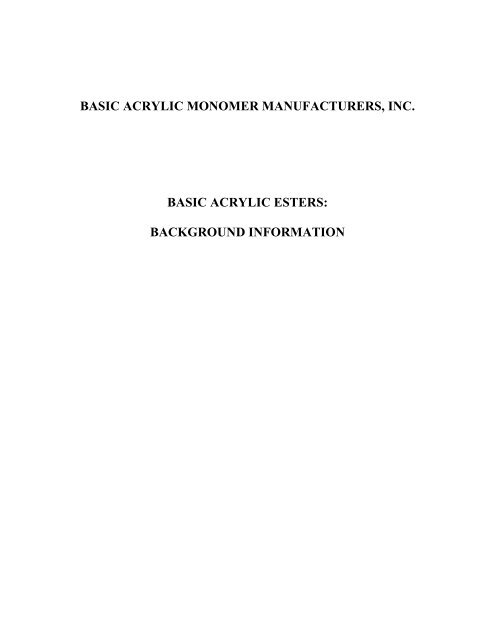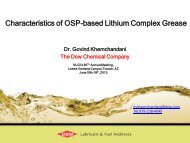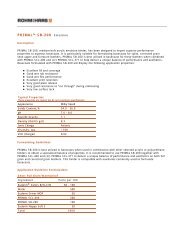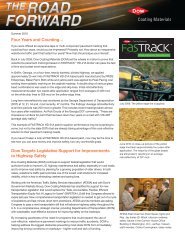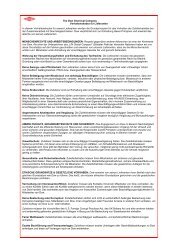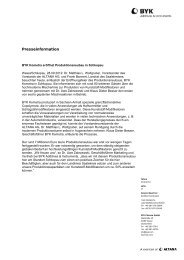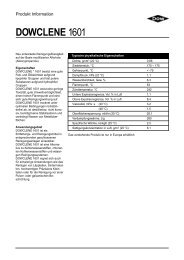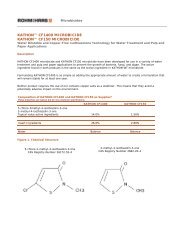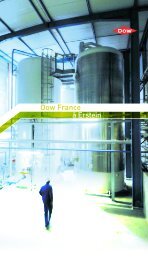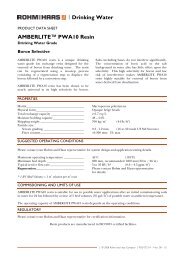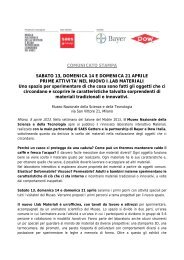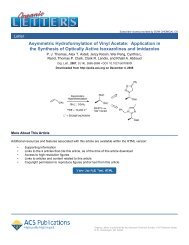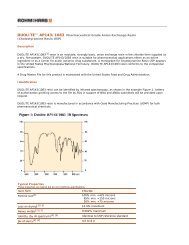basic acrylic monomers association (bamm) - The Dow Chemical ...
basic acrylic monomers association (bamm) - The Dow Chemical ...
basic acrylic monomers association (bamm) - The Dow Chemical ...
Create successful ePaper yourself
Turn your PDF publications into a flip-book with our unique Google optimized e-Paper software.
BASIC ACRYLIC MONOMER MANUFACTURERS, INC.<br />
BASIC ACRYLIC ESTERS:<br />
BACKGROUND INFORMATION
NOTICE<br />
BAMM is a nonprofit, tax-exempt incorporated <strong>association</strong>, which has<br />
developed these materials to provide general background information on<br />
<strong>acrylic</strong> acid and the <strong>basic</strong> acrylate <strong>monomers</strong>. Use of this information is<br />
voluntary and should only be undertaken after an independent review of<br />
the applicable facts and circumstances of particular situations. Users<br />
should also consult the appropriate Material Safety Data Sheet (MSDS)<br />
for up-to-date information and precautions for safe handling and use of<br />
these chemical products. Although BAMM has made all reasonable<br />
efforts to present accurate information and guidance, no guarantees<br />
or warranties, including any express or implied warranties of<br />
merchantability or fitness, are made with respect to this material by<br />
BAMM, its officers, directors, members or agents. In addition, no<br />
liability, loss or damage is assumed, and all liability for any government<br />
fines or penalties, or any other claim, demand, or loss for negligence or<br />
misconduct of any kind, is expressly disclaimed, whether direct,<br />
indirect, or consequential.
ABOUT BAMM<br />
<strong>The</strong> Basic Acrylic Monomer Manufacturers, Inc. (BAMM) is a trade <strong>association</strong> of<br />
manufacturers and importers of <strong>acrylic</strong> acid and its <strong>basic</strong> esters including butyl<br />
acrylate, ethyl acrylate, methyl acrylate and 2-ethylhexyl acrylate. BAMM current<br />
membership includes: BASF Corporation; Elf Atochem North America, Inc.;<br />
Celanese Ltd; Rohm and Haas Company; and Union Carbide Corporation.<br />
ABOUT THIS BROCHURE<br />
Basic Acrylic Monomers – <strong>acrylic</strong> acid and its esters – are versatile chemicals that<br />
have widespread use. <strong>The</strong> manufacturers, and others, have conducted scientific<br />
studies on the health and environmental effects of these products. This brochure<br />
provides a summary of technical, exposure, and regulatory information for use by<br />
government officials, health professionals, and others who would like a brief<br />
introduction to the data. This brochure includes data that BAMM is aware of as of<br />
the date of publication. BAMM has been careful to accurately summarize the data<br />
and conclusions; however, newer data may be or become available.<br />
Users should also consult their suppliers’ Material Safety Data Sheet (MSDS) for<br />
up-to-date information and precautions for safe handling and use of these chemical<br />
products.<br />
Page 1
INTRODUCTION<br />
Acrylic acid has served, for more than 30 years, as an essential building block in<br />
the production of some of our most commonly used industrial and consumer<br />
products.<br />
Approximately two-thirds of the <strong>acrylic</strong> acid manufactured in the United States is<br />
used to produce <strong>acrylic</strong> esters – methyl acrylate, butyl acrylate, ethyl acrylate, and<br />
2-ethylhexyl acrylate – which, when polymerized (see below), are ingredients in<br />
paints, coatings, textiles, adhesives, plastics, and many other applications.<br />
<strong>The</strong> remaining one-third of the <strong>acrylic</strong> acid is used to produce poly<strong>acrylic</strong> acid, or<br />
crosslinked poly<strong>acrylic</strong> acid compounds, which have been successfully used in the<br />
manufacture of hygienic products, detergents, and waste water treatment<br />
chemicals.<br />
Polymerization<br />
Acrylic <strong>monomers</strong> are highly reactive chemicals and, therefore, are used nearly<br />
exclusively as intermediates in the production of other materials. For example,<br />
individual molecules of <strong>acrylic</strong> acid or esters, called “<strong>monomers</strong>,” readily combine<br />
with themselves or other <strong>monomers</strong> to form long chains of repeating units, or<br />
“polymers.” <strong>The</strong> polymers have different physical and chemical properties than<br />
the constituent <strong>monomers</strong>.<br />
<strong>The</strong>se polymers can be used in the production of goods that for decades have<br />
provided added benefits and convenience to consumers and manufacturers<br />
worldwide.<br />
PHYSICAL PROPERTIES<br />
Methyl<br />
Acrylate<br />
Ethyl<br />
Acrylate<br />
Butyl<br />
Acrylate<br />
2-Ethylhexyl<br />
Acrylate<br />
Molecular Weight<br />
86 100 128 184<br />
Molecular Formula C4H602 C5H8O2 C7H12O2 C11H20O2<br />
CAS Number 96-33-3 140-88-5 141-32-2 103-11-7<br />
Boiling Point (°C) 80 100 148 216<br />
Freezing Point (°C)
EXPOSURE TO ACRYLIC ESTERS<br />
Acrylate vapor has a very strong acrid odor that leads to early detection of any<br />
potential releases. <strong>The</strong> following table contains a list of current standards for<br />
levels to which the standard-setting bodies consider that most workers can be<br />
exposed during an 8-hour workday without harmful effects, as well as the results<br />
of tests used to determine the levels at which the acrylates usually will be smelled.<br />
As illustrated, acrylate odor usually will be detected before it reaches the levels of<br />
the current standards. While unpleasant, smelling acrylate vapor is not necessarily<br />
indicative that such levels have been exceeded.<br />
OSHA Permissible<br />
Exposure Limit (ppm)<br />
ACGIH Threshold<br />
Limit Value® (ppm)<br />
Odor Threshold<br />
(ppm)<br />
Methyl<br />
Acrylate<br />
10, skin<br />
2, skin,<br />
sensitzer<br />
0.014 to 0.020<br />
Ethyl<br />
Acrylate<br />
25, skin<br />
5, A4<br />
15 ppm STEL<br />
0.00036 to 0.001<br />
Butyl<br />
Acrylate<br />
none<br />
2, A4, sensitizer<br />
0.0001 to 0.009<br />
2-Ethylhexyl<br />
Acrylate<br />
none<br />
Not<br />
established<br />
0.016 to 0.18<br />
Because consumer products contain only trace levels of <strong>acrylic</strong> esters as a result of<br />
the polymerization process, consumers are not generally exposed to these<br />
compounds in finished products. Although potential for exposure does exist<br />
during <strong>acrylic</strong> ester manufacture, transportation, and use, enclosed systems limit<br />
the exposure to worker populations and nearby communities. Employees and<br />
contractors involved in <strong>acrylic</strong> ester manufacturing should wear appropriate safety<br />
equipment and undergo special training.<br />
In spite of the manufacturer’s efforts to contain the manufacturing process, vapors<br />
can potentially escape from leaks in the piping system, during repair or<br />
replacement of the piping system (including tanks and reactors), or during removal<br />
of samples for quality control purposes. Worker exposure should be monitored in<br />
manufacturing facilities with specialized monitoring systems. Because odors will<br />
be detected at such low levels, leaks should be detected and repaired before a<br />
product can cause adverse health effects<br />
Exposure could also occur during loading, unloading, and transportation of tank<br />
trucks, railroad tankers, barges, and drums. However, dedicated systems designed<br />
to handle <strong>acrylic</strong> esters are typically used for loading and unloading purposes and<br />
procedures should be in place to prevent spills or leaks during transportation.<br />
Page 3
TOXICOLOGY PROFILE<br />
<strong>The</strong> likely primary routes of human exposure to the <strong>acrylic</strong> esters are skin contact<br />
and inhalation; toxicity is due to tissue damage at the site of contact. <strong>The</strong> undiluted<br />
esters are moderately irritating to corrosive liquids that can cause permanent tissue<br />
damage upon direct contact with the body. Contact with dilute solutions of the<br />
esters or monomer vapors can be irritating to the skin, eyes and respiratory tract.<br />
In animal studies, the irritation caused by repeated exposure to <strong>acrylic</strong> esters vapor<br />
at levels exceeding the TLV® has resulted in nasal lesions. <strong>The</strong> esters have caused<br />
skin sensitization, and individuals allergic to one ester may exhibit a sensitization<br />
reaction when exposed to other esters.<br />
In general, the esters that are absorbed are rapidly broken down in the body by two<br />
different mechanisms. <strong>The</strong> resulting metabolites are eliminated via expired air and<br />
urine.<br />
Toxicity associated with repeated exposures of experimental animals to acrylate<br />
esters typically has been comprised of changes in body and organ weights as well<br />
as clinical chemistry. Although the National Toxicology Program has determined<br />
these results are not relevant to man, ethyl acrylate has caused tumors in animals<br />
when large doses were injected by tubes directly into the animals’ forestomachs.<br />
Except for dermal and nasal lesions which have been observed at the site of<br />
contact, the microscopic examination of other body tissues post-exposure has<br />
indicated no significant difference compared to non-exposed animals.<br />
<strong>The</strong> acute toxicity of <strong>acrylic</strong> acid to fish and invertebrates ranged from “slightly”<br />
toxic to “practically non-toxic.” <strong>The</strong> acute toxicity of the <strong>acrylic</strong> esters was<br />
“moderately” toxic. Acrylic acid and the <strong>acrylic</strong> esters tested do not accumulate in<br />
the environment. If released to surface water, <strong>acrylic</strong> acid and the esters would all<br />
be rapidly biodegraded; some portion should volatilize to the air.<br />
Page 4
REGULATORY STANDARDS<br />
<strong>The</strong> manufacture, transportation, and use of <strong>basic</strong> acrylates are regulated or<br />
addressed by a number of government agencies and other expert groups to control<br />
exposure to workers and the environment. <strong>The</strong> following table records major U.S.<br />
federal regulatory and similar information as of June 1999. Such regulations<br />
frequently change, and many states and localities adopt their own regulations.<br />
<strong>The</strong>refore, you should consult applicable laws and regulations, as well as the<br />
manufacturer’s MSDS, for current requirements.<br />
REGULATORY STANDARDS<br />
Methyl Ethyl Butyl 2-Ethylhexyl<br />
Acrylate Acrylate Acrylate Acrylate<br />
OSHA PEL 10 ppm,<br />
skin<br />
25 ppm, skin none none<br />
ACGIH TLV® 2 ppm, 5 ppm 2 ppm, none<br />
skin,<br />
sensitizer<br />
15 ppm STEL sensitizer<br />
IARC 3 2B<br />
(Suspect<br />
Human<br />
Carcinogen)<br />
3 none<br />
NTP BRC no See footnote 3<br />
no no<br />
DOT Hazard Class flammable flammable,<br />
corrosive<br />
flammable no<br />
SARA/CERCLA RQ no 1000 lbs no no<br />
SARA §313 yes yes yes no<br />
RCRA no yes no no<br />
CAA §112(b) no yes no no<br />
CWA no no no no<br />
FDA Uses 1<br />
NFPA Rating:<br />
yes yes yes yes<br />
2<br />
• Health 2 2 2 2<br />
• Flammability 3 3 2 2<br />
• Reactivity 2 2 2 2<br />
1 Acrylic esters used as monomer to make specific polymers are listed for certain, specific indirect food additive uses.<br />
2 NFPA Rating Definitions: 2/Health=Materials hazardous to health, but areas may be entered with full-face mask, self-contained breathing<br />
apparatus which provides eye protection; 2/Flammability =Materials that must be moderately heated before ignition will occur;<br />
3/Flammability=Materials that can be ignited under almost all normal temperature conditions; 2/Reactivity=Materials that (in themselves) are<br />
normally unstable and readily undergo violent chemical change but do not detonate.<br />
3 Recommended to be delisted from the NTP Report on Carcinogens, December 1998. Final decision expected in 1999. Listed in the 8 th Annual<br />
Report on Carcinogens as “Reasonably Anticipated to be a Carcinogen.” See 63 Fed. Reg. 68763 (Dec. 14, 1998)<br />
Page 5
ACRONYMS<br />
ACGIH TLV®<br />
CAA<br />
CWA<br />
DOT Hazard Class<br />
FDA<br />
IARC<br />
NFPA<br />
NTP BRC<br />
OSHA PEL<br />
RCRA<br />
SARA/CERCLA RQ<br />
SARA 313<br />
American Conference of Governmental Industrial<br />
Hygienists, Threshold Limit Value®<br />
Clean Air Act, §112(b)<br />
Clean Water Act, §§116.4, 112 App. D, 131.36, 401.15,<br />
423 App. A.<br />
Dept. Of Transportation: Hazard Class 49 C.F.R.<br />
§172.101<br />
Food & Drug Administration: 21 C.F.R. Parts 174 to 178<br />
International Agency for Research on Cancer<br />
National Fire Protection Association<br />
National Toxicology Program Biennial Report on<br />
Carcinogens<br />
Occupational Safety and Health Administration,<br />
Permissible Exposure Limit, 29 C.F.R., Table Z,<br />
§1910.1200<br />
RCRA - Resource Conservation and Recovery Act, 40<br />
C.F.R. §261.33<br />
Superfund Amendments and Reauthorization Act (1986),<br />
40 C.F.R. §375/Comprehensive Environmental<br />
Response, Compensation, & Liability Act (1980), 40<br />
C.F.R. §302.4 Reportable Quantity<br />
Section 313 of Title III of SARA - Toxic Release<br />
Inventory Reporting & Community Right-To-Know, 40<br />
C.F.R. §72.65<br />
Page 6
FOR MORE INFORMATION<br />
For more information, please contact your supplier or BAMM at the following<br />
address:<br />
1250 Connecticut Avenue, N.W.<br />
Suite 700<br />
Washington, DC 20036<br />
Office: (202) 637-9040<br />
Fax: (202) 637-9178<br />
Email: ekhunt@aol.com<br />
Page 7


